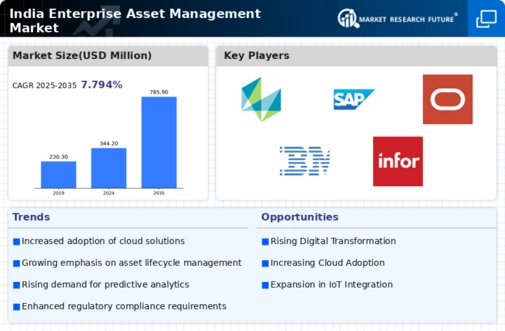Regulatory Compliance and Standards
In India, the enterprise asset-management market is significantly influenced by the need for regulatory compliance and adherence to industry standards. Organizations are increasingly required to comply with various regulations, such as the Companies Act and environmental laws, which necessitate effective asset management practices. This compliance drives the demand for robust asset-management solutions that can ensure transparency and accountability. As a result, the market is expected to witness a growth rate of around 10% as companies invest in systems that facilitate compliance reporting and risk management. The emphasis on regulatory adherence not only enhances operational integrity but also fosters trust among stakeholders, thereby propelling the enterprise asset-management market forward.
Shift Towards Digital Transformation
The digital transformation trend is reshaping the enterprise asset-management market in India. Organizations are increasingly adopting digital technologies to enhance their asset management capabilities. This shift is characterized by the integration of data analytics, artificial intelligence, and machine learning into asset management processes. As companies recognize the potential of these technologies to provide actionable insights, the market is anticipated to grow at a rate of around 14%. Digital transformation enables organizations to make data-driven decisions, optimize asset performance, and improve overall operational efficiency. This trend not only enhances competitiveness but also positions the enterprise asset-management market as a critical component of modern business strategy.
Growing Demand for Operational Efficiency
The pursuit of operational efficiency is a primary driver of the enterprise asset-management market in India. Organizations are increasingly recognizing the importance of optimizing asset performance to enhance productivity and reduce costs. This trend is particularly evident in sectors such as manufacturing and utilities, where asset downtime can lead to substantial financial losses. As a result, companies are investing in enterprise asset-management solutions that provide insights into asset performance and maintenance needs. The market is projected to grow by approximately 15% as businesses seek to implement predictive maintenance strategies and streamline their operations. This focus on efficiency not only improves profitability but also contributes to sustainable practices within the enterprise asset-management market.
Technological Advancements in Asset Management
The enterprise asset-management market in India is transforming due to rapid technological advancements. The integration of advanced software solutions and automation tools is enhancing operational efficiency. As organizations increasingly adopt cloud-based platforms, the market is projected to grow at a CAGR of approximately 12% over the next five years. This shift allows for real-time monitoring and management of assets, leading to improved decision-making processes. Furthermore, the adoption of mobile applications is facilitating on-the-go access to asset data, which is crucial for field operations. Consequently, these technological innovations are driving the enterprise asset-management market, enabling businesses to optimize their asset utilization and reduce operational costs.
Increased Investment in Infrastructure Development
India's ongoing infrastructure development initiatives are significantly impacting the enterprise asset-management market. The government's focus on enhancing transportation, energy, and urban infrastructure is driving the need for effective asset management solutions. As investments in infrastructure projects rise, estimated to reach $1 trillion by 2025, the demand for enterprise asset-management systems is expected to grow correspondingly. These systems are essential for managing the lifecycle of assets, ensuring that they are maintained and utilized effectively. Consequently, the enterprise asset-management market is likely to expand as organizations seek to implement comprehensive asset management strategies that align with national development goals.
















Leave a Comment